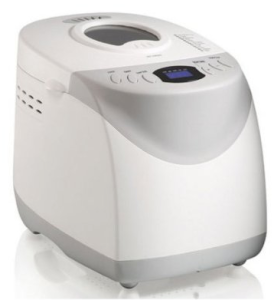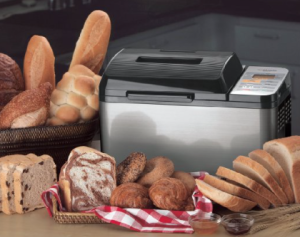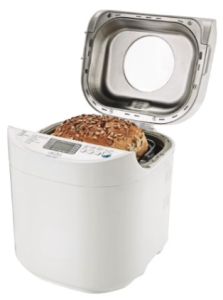Formerly a specialty item, bread maker machines have become very popular among cooking enthusiasts everywhere, because modern innovations have turned the simple bread machine into a portable bakery. It takes a lot of time, energy, and skill to make bread from scratch. Very few people know how to properly mix in each of the ingredients, properly knead the dough, proof it, and bake the bread, and even fewer people have all the equipment needed to do it. With a modern bread machine, you can make bread without having any previous experience baking or expending any extra effort. All the user has to do is add a few ingredients and press a button, and the bread machine will do all the heavy lifting.
One of the major benefits of using a bread machine is how convenient it is. After you measure out your ingredients and input a few settings, you simply have to wait a few hours for your bread to be done. Many bread machines don’t require constant attention or any input from the user after startup, so you now have time to work on other recipes while the bread is baking. These machines have undoubtedly been around for a while, but bread machines today are much more technologically advanced and offer more features than even. Top-of-the-line models can mix ingredients, perform every important step at an exact time, knead the dough, and produce fresh, bakery-quality bread without needing extra user inputs. Some advanced bread machines can be programmed to finish the bread at a certain time, so you can have a loaf of bread ready for dinner or for when you’re expecting guests.
What to Consider When Shopping for a Bread Maker Machine
Loaf Size
One of the most important parts of a bread machine is the size of the loaf the machine produces. Many modern brands have options for making different loaf sizes, so you will have enough bread for any occasion. They generally make loaves that weigh 1 pound, 1.5 pounds, and 2 pounds. As a general rule, it’s wise to buy a bread machine that produces loaves in different sizes. Different recipes will call for different sizes of loaves, so unless you want to make the same loaf of bread over and over, it’s good to have a variety of sizing options.
Bread Orientations
About a decade ago, bread machines were only able to produce square shaped loaves of bread, which took many hours to produce and didn’t have the same consistency as bread from a bakery. Today, bread makers produce traditional looking horizontal loaves that taste and feel like they came directly from the bakery.
 Types of Bread
Types of Bread
A mid-range bread machine is programmed to handle most types of bread, including all the most popular types that you would find at a bakery. There’s usually a control panel on the front face of the machine, which allows you to select your baking options and the type of bread. Once you’ve selected the type of bread, the machine automatically adjusts the settings for kneading, baking, and proofing the bread. Even though the types of bread that can be used vary from machine to machine, many bread makers can bake whole-wheat bread, artisan bread, sweet bread, and gluten-free bread. The user needs to add the correct ingredients and select the correct settings, but the guesswork that comes with baking is removed in its entirety. A good idea is to read the instruction manual of your bread machine on how to use it in the best way.
Versatility
One of the most impressive features of a modern bread maker machine is its wide array of applications beyond simply baking bread. Along with kneading and proofing bread, many machines can also be used to make pizza and pasta dough. Some machines can even be used to bake cakes. This versatility is usually only found in high-end models, but bread machines have become more useful as time has gone on. Usually you’d only use a bread machine every once and a while or on a special occasion, but now that the machine works across a variety of applications it can become a permanent fixture in your kitchen.
Some models of bread machine include an internal rack that can be used to bake baguettes and other specialty breads. When the user want to go back to baking regular loaves of bread, the rack can be removed and stored. Internal baking racks are usually sold as aftermarket accessories, but some high-end bread machines come standard with the accessory.
Internal Computer Chips
One of the newest features implemented in bread makers is the addition of microprocessors to ensure that the bread is baked the same way every time. Differing from old-fashioned bread machines, the new microprocessor removes the unpredictability of old machines that simply has a heating element and a timer. The microprocessor can make small adjustments to the heat over time, to ensure that the bread is baked thoroughly.
Bread makers with microprocessors are pretty common, but they still go for slightly more than a conventional bread machine. Many people say that a small increase in price is worth it, because the processors help remove any inconsistencies in the baking process. The microprocessor also cuts down on the amount of time needed to bake the bread. Many bread machines with internal computer chips come with rapid-bake settings that can decrease the baking time of a loaf of bread to an hour.
Important Features to Look For
Along with the extra benefits that come with a modern bread machine, it’s important to keep these key features in mind when purchasing the appliance. These features help you to make a homemade bread.
Kneading Blades
Many bread machines come with one or 2 kneading blades, but many users feel that two kneading blades perform better than a bread machine with just one. The difference in cost between a bread maker with a single kneading blade and one with 2 is very minimal, so it’s always a good idea to pick up a two-bladed bread maker.
Convection Cooking
The majority of bread makers have 3 settings for light, medium, as well as dark crusts, which directly related to the amount of heat applied to the crust. On older machines, the crust settings would simply cook the bread for longer, often burning the bread if it was put on a medium or high setting. To achieve an even coloring and a crisp crust, bread machines swapped out their simple heating elements for a convection heating system.
Similar to an oven that you’d find in a professional bakery, convection ovens provide an even amount of heat to the entire cooking chamber by using a fan to distribute the heated air. Convection cooking also relies on the oven’s walls to transfer heat to the food. Models that come with convection heating are usually found at a higher price than models with simpler heating systems, but convection heating will save you time, money, and aggravation. By evening out the amount of heat applied to the bread dough, the bread is less likely to burn or cause problems when in the final stages of baking.
Ingredient Dispersal
When making certain types of breads, certain ingredients need to be added in later in the cycle. For instance, if you’re baking bread with nuts or dried fruit, then you’ll need to add the ingredients as the dough begins to rise. Some machines allow the user to open up the bread maker mid-bake to add the ingredients, but most of the time, the bread machine will not open until the process is finished. Advanced bread machines have a separate compartment where the ingredients can be placed during startup, and then halfway through the baking process the ingredients are automatically added at the correct time. Typically, an internal ingredient dispenser is usually used for adding yeast to the dough.
Additional Features and Design Choices
Along with the main bread-making features, many modern bread machines come with optional extras that make operating the appliance easier than ever. Here are a few optional designs and features:
- Top-Loading Machines – The majority of machines load from the top because it offers the user the utmost convenience.
- Safety Features – A typical bread machine comes with several internal safety fuses to prevent the device from overloading and short-circuiting. Along with the standard fuses, many bread machines come with power interruption protection, which will protect your device in the event of a power outage. With power interruption protection, the bread machine will continue where it left off after the power comes back on, so you don’t have to throw out the bread it was baking
- Baking Pan – After baking a loaf of bread, many people have noticed that the ingredients leave quite a mess on the baking pan, which can be difficult to clean off. This is why many bread machines now come with non-stick baking pans, which help with cleanup. Most of the time, the baking pan cannot be removed, so a non-stick pan is important because it can be very difficult to clean out a pan while it’s still inside the bread maker
Display Screens and Windows
Usually found in high-end bread makers, LCD display screens can be very useful for checking the progress of your bread and changing settings during startup. A feature that’s more widely available is a viewing window that’s built into the bread maker.
How to use a bread maker machine?
Although every bread machine is a little bit different, the general usage of this household appliance is the same for every model. Some have more features in which you can select other settings. Make sure you read through the quick instructions on how to use your specific bread maker and for extra guidance and tips you can watch this youtube movie. The whole process is explained very well and clear.




